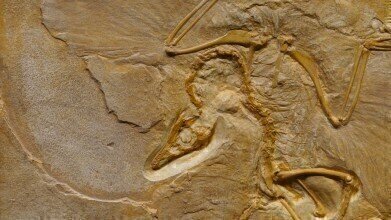News
Bat-Dinosaur Fossil Discovered in China
May 22 2015
Researchers have announced the discovery of a new dinosaur fossil: a glider with wings which is similar to both birds and bats. It has been named Yi qi (Strange Wing) and is a small feathered dinosaur from the Middle Jurassic age fossil beds of China that have yielded a host of important fossils in recent years.
'Strange Wing'
Yi qi, like many other small dinosaurs, is preserved with a full coating of feathers and was a close relative of the lineage that ultimately gave rise to birds.
What sets this animal apart, however, is the composition of its wings. In addition to some unusual feathers there is a membrane-like soft tissue that would have given the animal wings very similar to bats.
Yi qi s not a direct ancestor of birds, and has nothing to do with the origins of the mammalian bat species but its wings are an excellent example of convergent evolution. In addition to bats which are capable of active powered flight, various passive gliders like flying squirrels, sugar gliders and the so-called “flying lemurs” have all independently evolved some extension that helps to support a membranous wing, but it is a real shock to see it in a dinosaur.
Professor Xu Xing, lead author of the study from the Institute of Vertebrate Paleontology and Paleoanthropology, Beijing said “It definitely evolved a wing that is unique in the context of the transition from dinosaurs to birds.”
Experimenting with flight
There are a number of feathered dinosaurs close to the origins of birds that are thought to have been some form of glider. All were small and light with extensive feathers that would have formed the flight surface and allowed them to move effectively through the air.
However, it is remarkable that an animal which had numerous relatives with large feathers on their arms and would apparently “experiment” with different forms of flight at various times, would take such a dramatically different route towards gliding, even if it was one commonly explored by other mammals.
Evolutionary implications
There have already been suggestions that perhaps powered flight evolved multiple times in the dinosaurs and early birds, with several different groups making the final jump from gliding to a more active form of movement in the air.
Professor Xu notes that “We don’t know if Yi qi was flapping, or gliding, or both” - but it does seem clear that the small size of the animal and large surface area of the wings and feathers would have permitted some form of aerial locomotion. The pathway to both birds and powered flight from small feathered dinosaurs shows a relatively consistent progression but Yi qi adds a new twist - with one evolutionary branch taking a dramatically different route into the air.
More discoveries from China
Yi qi isn't the only recent discovery from China. A new bird species has been discovered in central China by an international team of scientists. You can read more about this update in: Introducing the Sichuan Bush Warbler – A New Species of Bird.
Digital Edition
Lab Asia Dec 2025
December 2025
Chromatography Articles- Cutting-edge sample preparation tools help laboratories to stay ahead of the curveMass Spectrometry & Spectroscopy Articles- Unlocking the complexity of metabolomics: Pushi...
View all digital editions
Events
Jan 21 2026 Tokyo, Japan
Jan 28 2026 Tokyo, Japan
Jan 29 2026 New Delhi, India
Feb 07 2026 Boston, MA, USA
Asia Pharma Expo/Asia Lab Expo
Feb 12 2026 Dhaka, Bangladesh



















